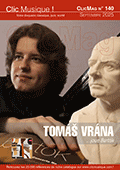 Depuis les enregistrements historiques de Jean-Pierre Rampal, Alain Marion, Christian Lardé, Robert Veyron-Lacroix, Paul Hongne pour Le Club français du disque (1965), passés ensuite par Vox musicalis, Musidisc ou The Record Society (1978), la musique pour flûte du jeune Beethoven n’a cessé de retenir l’attention de nombreux interprètes. Soit pour des extraits, mettant spécialement en avant les Airs nationaux variés op. 105 et 105 et la Sérénade pour Flûte, violon et alto op. 25, qui sont probablement les œuvres les plus dignes d’intérêt de ce catalogue. Kazunori Seo releva le défi de l’intégrale pour Naxos. Emmanuel Pahud, puis Juliette Hurel, Severino Gazelloni enregistrèrent la Sérénade op. 25… Philippe Bernold en joue parfois au concert quelques pièces. Il faut dire que, sous l’influence encore sensible de Haydn, même pour les opus 105 et 107 (Artaria, 1819), pourtant contemporains en principe de la Missa Solemnis, ces œuvres dégagent un charme indéniable immédiatement accessible au plus grand nombre et offrent une image infiniment plus légère et plaisante du génie torturé et colérique (Die Wut uber den verlorenen Groschen, op. 129) que l’on identifie souvent à Beethoven. Ginevra Petrucci, Gian-Luca Petrucci, flute, Giovanni Auletta, piano, Francesco Bossone, bassoon, Mirei Yamada, violin, Luca Sanzò, viola, instrumentistes réunis à l’occasion de ces trois CDs, nous offrent ici des interprétations de grande qualité, vivantes et flatteuses pour leurs instruments, mais parfois desservies par une prise de son un peu sèche, plus adaptée au jazz, ce qu’explique sans doute la localisation du studio (Casa del Jazz de la Villa Osio à Rome). Les amateurs d’auditions comparatives se rappelleront que Clic Mag avait également chroniqué l’enregistrement en deux CDs de la même somme par Enzo Caroli et Walter Zampiron (flûte), avec leurs comparses : Anna Martignon et Jung Hun Yoo (piano), Carla Lazzari (violon), Giancarlo Di Vacri (alto), Roberto Giaccaglia (basson), Urania LDV14087. Bien malin qui les départagerait aujourd’hui sous le seul angle de la qualité des interprétations ! (Jacques-Philippe Saint-Gerand)  Showpiece variations, folksongs, little-known trios and an early masterpiece: an unrivalled survey of Beethoven’s flute writing in new recordings by experienced Italian chamber musicians. Beethoven’s attitude to composition is exemplified by an 1806 letter to the Scottish publisher George Thomson: ‘I will endeavour to make these compositions as pleasant as possible, but to the extent that this can remain compatible with the perfection and originality of style which you yourself have judged to be favourable characteristics of my work and which I will never give up.’ Thomson wanted undemanding and commercially attractive folksong settings from a composer already across Europe. Beethoven wanted and needed the money, but he also knew his worth, and in any case compromise was a word only ever grudgingly admitted to his vocabulary. In writing his sets of folksong variations, the result always falls easily upon the ear while putting amateur musicians through their paces, technically speaking, and demanding far more of their expressive imagination than Thomson’s usual fare. The other pieces here date from Beethoven’s earliest years as a composer in Bonn. The Trio for flute, bassoon and piano shows a strong Mozartian influence; the B flat Sonata for flute and piano is a striking example of the apprentice musician learning his craft and refining his voice, which emerges in the unexpected context of a modest Duo for two flutes. However, it is the seven-movement Serenade Op.25, scored for flute, violin and viola, where we find Beethoven most elegantly adapted to the role of ‘occasional’ composer. The idiom might be carefree and elegant, but the instruments cross swords, argue and find common ground with a nobility that is all Beethoven’s own. These new recordings are led by the flautist Ginevra Petrucci, who is now based in New York as a performer, editor and author of several volumes on the flute, and a specialist in new music. ‘A a very talented and well-educated musician,’ according to the Fanfare magazine review of her Brilliant Classics album of flute concertos by Briccialdi (95767).
 |
